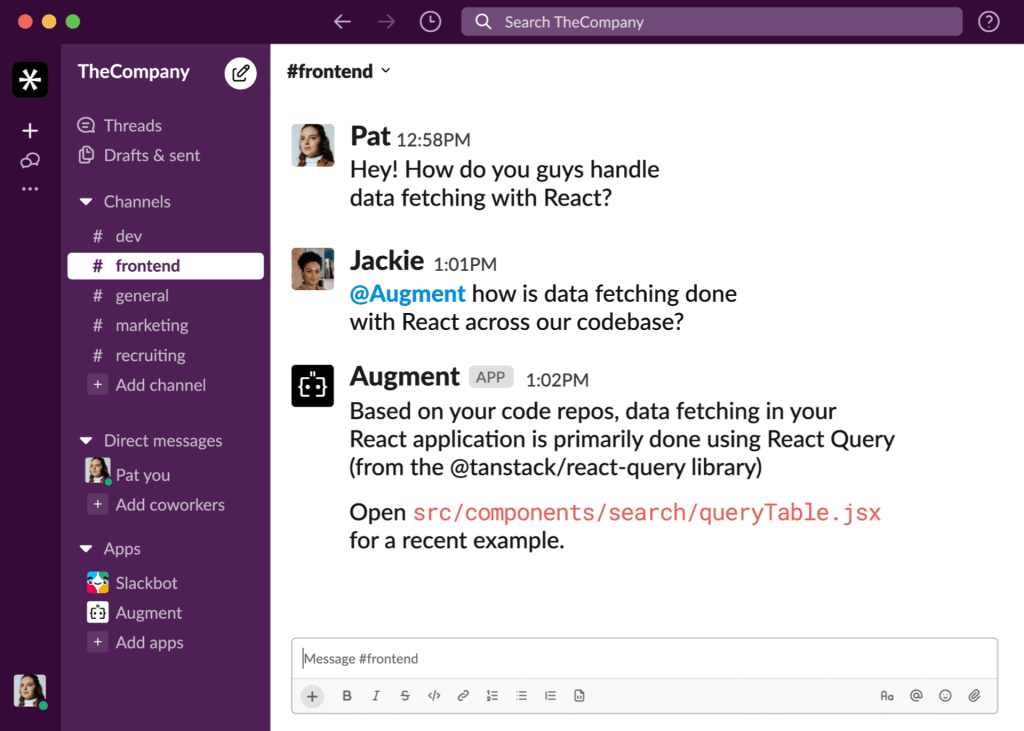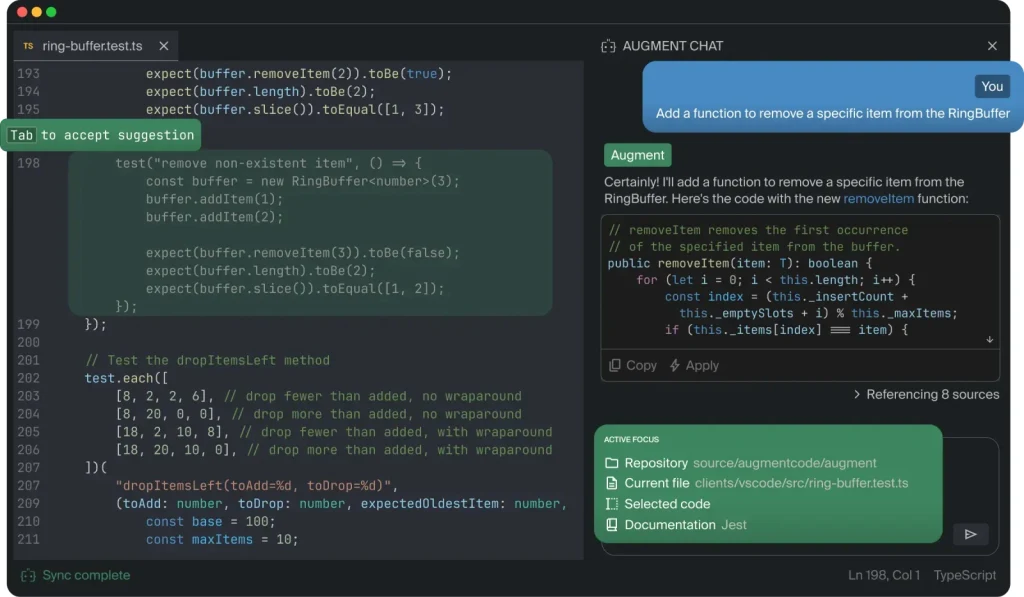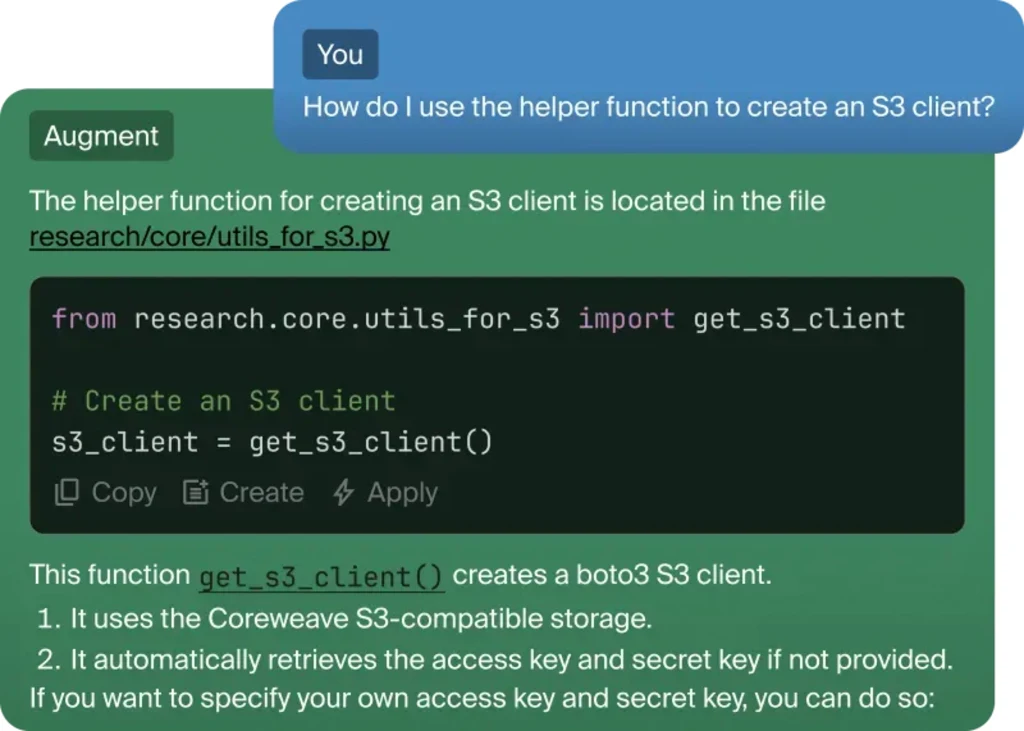An AI coding assistant called Augment Code is hoping to make programmers—and their teams—more efficient.
And while it’s competing against a variety of other coding assistants, including Microsoft’s GitHub Copilot, Augment CEO Scott Dietzen says his company’s tool is designed to be faster than the competition, meaning developers don’t lose focus waiting for it to offer suggestions.
Augment Code is automatically tuned to a company’s specific codebase, Dietzen says, which means developers spend less time tweaking code it generates to fix things like formatting styles. That specific knowledge also means it can answer detailed questions about a company’s code, which can help make entire teams more efficient, as new hires can pose many questions to the AI rather than to senior employees busy with their own work.
“It can take the load off of the senior devs on the team, as well as ramp new hires dramatically faster,” he says.
The Augment AI can respond to questions in Slack, which means teams can also ask it questions about the state of a project’s code, then assign someone to tackle next steps in the same conversation. The tool, available for $60 per active developer per month, also plugs in to popular development environments, including Microsoft’s Visual Studio Code and the JetBrains suite of tools, to deliver code completion suggestions as programmers work.

Augment uses retrieval-augmented generation (RAG), an increasingly common technique of pointing generative AI to the relevant section of a document or source code to offer a suggestion or answer to a question. That means that the company doesn’t need to develop specific, costly new models for each customer’s code, so it can stay in sync as users update their code without needing a lengthy and expensive retraining step. Since it has knowledge of a company’s code as a whole, it can also inform programmers where additional changes need to be made to keep a project up to date as one area of code is changed. It can also spot ways existing code can be invoked elsewhere in a project instead of just suggesting unnecessary new code to address similar needs.
“Because we understand your code, we can help you reuse code,” Dietzen says. “Other AIs want to try to get you to add ever more code into your codebase, which actually reduces software quality rather than improving it.”

The AI also has access to documentation for common third-party libraries that developers frequently integrate with, but Augment also doesn’t train its general-purpose models on proprietary customer code, which eliminates the risk of the AI leaking one customer’s data to another, Dietzen says.
“It’s always up to date and no risk to intellectual property,” he says.
The AI can help developers work more quickly and accurately by quickly hammering out sections of boilerplate code and language for automated testing, letting users focus on the bigger picture or more complex aspects of a project.

“A lot of work in the past has been limited by how fast you can type,” says Zach Johnson, cofounder of Augment customer LMNT, a text-to-speech AI company. “What’s changed is a bunch of that sort of performative work has disappeared.”
That can ideally lead to less developer burnout. It can also mean faster turnaround times for projects without needing to add new developers.
One customer, software engineering consultancy Codem, frequently works with clients to transfer aging e-commerce sites to more modern software environments. Cofounder Marcelo Wesseler says it historically took about two or three months to fully understand the code behind a legacy site and rebuild it on a current platform, but with Augment in place, it can take as little as six weeks. Developers at Codem can use Augment to answer questions about the legacy code, then have it assist with reimplementing the logic in a new environment, often with fewer tweaks needed to the new code.
“The number of bugs you have to iron out later on is significantly less,” Wesseler says.
Dietzen says Augment uses its own AI internally to help develop software, as it looks to quickly add features and stay competitive in a rapidly evolving market. And, he says, he’s hopeful that the company’s tool can continue to make software more efficient to develop, benefitting not just coders and the companies who employ them but also the general app-using public.
“If we can double the productivity of human software developers, that is a profoundly large amount of additional software capability we can deliver to the world that I think can grow the economy and make everybody a lot happier with the software that they consume,” says Dietzen.
Login to add comment
Other posts in this group


Remember when Netflix cost $9 per month and The New York Times website was free? Well, the days of online media feeling like a bargain are long gone. Today, it’s become a costly


Welcome to the world of social media mind control. By amplifying free speech with fake speech, you can numb the brain into believing just about anything. Surrender your blissful ignorance and swall

Few periods in modern history have been as unsettled and uncertain as the one that we are living through now. The established geopolitical order is facing its greatest challenges in dec

Substack and Patreon are vying to become creators’ primary revenue stream.
For most influencers, payouts from platforms like Meta or Google aren’t enough to build a sustainable career. R

The European Commission is coming for “SkinnyTok.”
EU regulators are investigating a recent wave of social media videos that promote extreme thinness and “tough-love” weight loss advice,
